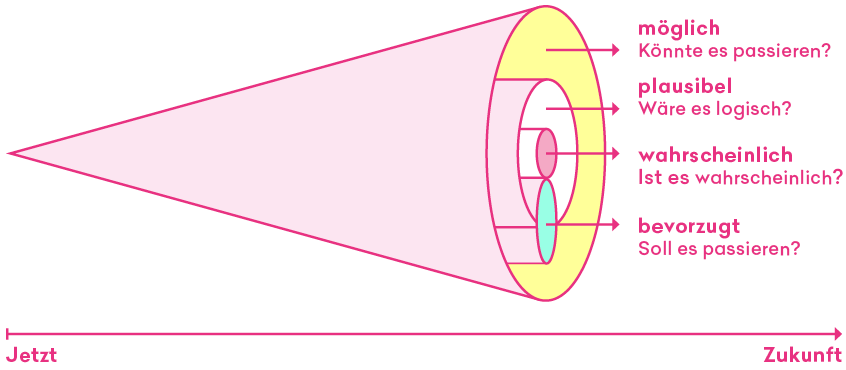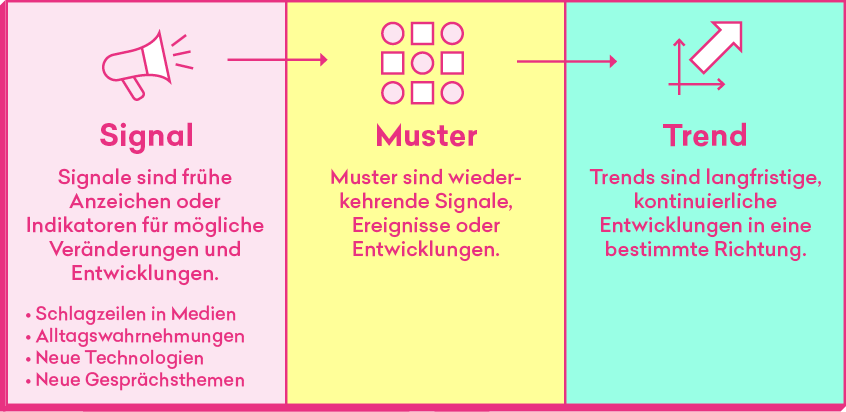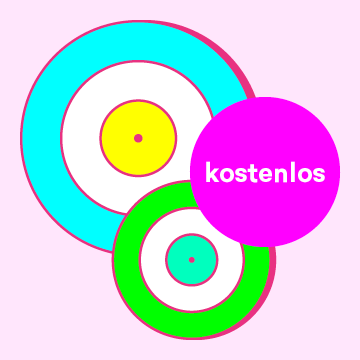Future Thinking – shaping the present from the future

What if you already knew what your market would look like in 10 years—because you chose that future yourself? Future Thinking combines approaches from futurology, psychology, and design management to derive possible futures from the “present” and work toward particularly desirable scenarios. We show why futures thinking beats classic foresight methods and why strategic planning without future thinking is doomed to failure.
Content
- Future Thinking – what exactly is it?
- Future Thinking or Futures Thinking?
- The future is not linear
- Why we need Future Thinking
- Futures thinking as a method
- Shaping the future with Wonderwerk
Future Thinking – what exactly is it?
For simplicity’s sake, Futures Thinking is often referred to as a method of futurology. In fact, Futures Thinking is the next level of futurology: the exploratory approach combines a variety of methods and practices of structured and strategic thinking about the future.
It is NOT about thinking about a state X ten years into the future in order to predict a future Y. It is about discovering concrete signals and clues in the present that point to possible changes in the future – and using these possible future scenarios to change the present.
Futures Thinking enables companies and organizations to take action. It is not about preparing for future changes, but rather about anticipating changes, risks and potential threats and actively promoting development in a positive direction (for the company/organization).
Future Thinking oder Futures Thinking?
“Futures Thinking is the plural form of Future Thinking. However, Futures Thinking is actually the more accurate term, because Future Thinking is actually about sketching multiple possible futures. This distinction is important because it emphasizes the active component of the method: Strategic thinking about the future is about making decisions and promoting certain developments over others.
But this is only possible if there are multiple future scenarios to choose from. This is why we call it Futures Thinking: thinking about all the futures that could be.
Underlying this strategy are three important principles that make thinking about the future so complex – and so essential for companies and organizations: The future is unpredictable, it is not predetermined, and it can be influenced. (Source: Roy Amara, 1981)

The future is not linear
Humans have always been obsessed with the future. So it’s no surprise that future and trendresearch hasproduced many different methods forpredictingdevelopments in the future: monitoring, scanning & naming, trend scouting and scenario techniques are just a few of the methods used to outline future developments using indicators in the here and now. The problem:
We are at a point in our history where future developments can no longer be derived linearly.
How likely was it that after the 2021 U.S. presidential election, about 1,000 Trump fans dressed in coyote fur would storm the Capitol demanding a correction of the election results? Who could have imagined a future with Donald Trump as President of the United States? Or the coronavirus crisis the year before, when the world went into a collective lockdown?
The acronym “VUCA” existed long before the future went off the rails. But what a volatile, uncertain, complex and ambiguous present REALLY means, we only know now – some two years after the chaos of the pandemic.
Future Thinking as a child of our time
In view of the developments of recent years, experts speak of a “collective loss of the future.” But with this sense of loss and the realization of how “VUCA” our world actually is, comes the desire to change precisely that:
The pandemic has shown us that the future can never be planned. But it has also shown us that we are not helplessly at the mercy of this development. And that the “future” is not something that simply happens to us, but something that we may not be able to plan, but can shape:
The future is unpredictable, but it can be shaped.
(Dr. Sohail Inayatullah, futurologist)
Why we need Future Thinking
Traditional foresight work relies primarily on the perspective of experts. However, this perspective is precisely the problem, because a perspective (especially that of a single person) is always shaped by experiences, prejudices, and assumptions that the person is often unaware of. The result: repetitive scenarios that usually paint a picture of “everything good” or “everything bad.”
Many companies and organizations face a similar problem when it comes to innovation management: The development of new products or services, e.g., with the help of design thinking, starts from the present perspective and is tested for its future viability with the help of target group tests, interviews, etc.
The problem with this approach is that no one (not even the test subjects themselves) can say how the target group will accept the product or service in a context other than the “present context.” To what extent could techno-logical developments influence their behavior? What possible socio-logical or economic developments could need to be taken into account?
At Wonderwerk, we solve this problem by expanding classic innovation management with methods and approaches from future thinking!
How does Future Thinking work?
Future Thinking deliberately breaks with black-and-white thinking and explores all possible scenarios for the future – simply because they are possible. With the help of qualitative surveys conducted in workshops and interviews, as well as consistent trend analysis, indicators for possible changes and developments are collected. Machine learning is also often used in the context of future thinking. Based on the data collected, patterns and recurring signals can be identified, enabling us to answer the following questions:
- What scenarios could theoretically happen in the future?
- Which scenarios would be logical?
- Which future scenarios are more likely than others?
And the most important question of all: Which scenarios DO we want to seecome true?
This process is often visualized using the so-called Future Cone (sources: Hancock and Bezold, 1994; Henchey, 1978):

Future Thinking is a method that can be used by companies and organizations in many contexts. Fundamentally, Future Thinking is about strengthening leadership skills, changing perspectives, and breaking old patterns. For this reason, the method is often used in kick-off events or as a means of getting teams (back) into action (reboot).
However, Futures Thinking offers the greatest advantage to companies and organizations in strategy development. The development of a corporate strategy is about identifying success potential for the future and developing a kind of “roadmap” for how the organization will get from A to B.
Futures Thinking fills a blind spot in this process: In view of a present that is constantly changing and a future that cannot be predicted, classic methods of strategy development that develop options for action based on existing information must fail.
Futures thinking as a management tool
Companies and organizations can use Futures Thinking as part of their strategydevelopment to
- validate the current corporate direction or make course corrections based on potential risks,
- identify the best or most promising options for action,
- prioritize activities and processes, and
- create the structural or organizational framework for important change processes (e.g., designing a new work setting or introducing an intrapreneurship program).
In addition to opening up creative spaces, Future Thinking also facilitates knowledge exchange between companies and organizations and helps to develop new ideas. By changing perspectives and bringing different stakeholders together, shared visions emerge.
Futures Thinking ensures that managers at all levels remain capable of acting while at the same time knowing that the goal is not fixed (and never can be).
Leadership based on Future-Thinking principles looks boldly to the future and promotes the creation of scope for action.
Futures Thinking as a method
Futures Thinking brings together various practices, methods, and disciplines. The method incorporates aspects of strategic foresight, Design Thinking, and speculative design. It is based on theories and models from psychology and the social, economic, and political sciences.
An essential part of future thinking is scanning signals in the present in order to identify patterns and developments with trend potential that could influence the future.

In order to understand how current signals could develop into possible futures, we use various methods in Future Thinking, such as future personas, STEEP/PESTE trend analysis, and scenario building. Methods such as visual thinking, future prototyping, and/or transformation storytelling are used to visualize these possible futures.
It is important that the future scenarios developed in this way become truly tangible for the respective company or organization. Only then can concrete recommendations for action for the present be derived from the futures that could be.
How the future becomes the present
The best model for the future is useless if it has no implications for the present. That is why foresight in Future Thinking is supplemented by what is known as backcasting. Backcasting describes the process of thinking about what steps could lie between the preferred future or the currently preferred possible futures and the present. This is NOT about achieving an arbitrary goal X:
Future Thinking as a method of strategy development is about bringing a future that is already in the making to fruition through concrete actions.


Shaping the future with Wonderwerk

Wonderwerk Consulting has been successfully supporting change processes in companies and public organizations for many years. We use future thinking as part of our strategy consulting services to work with our clients to create and implement future-proof business models and strategies. To this end, we combine foresight work with organizational development: Only when the structural and organizational conditions are right can you influence today what your market will look like in ten, 15, or 20 years.
Why Wonderwerk?
Because we too are obsessed with the future! That’s why we have been supporting and promoting intrapreneurship programs in the public sector for years and establishing targeted structures in which employees can unleash their full potential and drive innovation from within. For us, Future Thinking is the next level of this innovation energy. With us at your side, you are not only well equipped for the future: you create the future that works best for your company or organization!
Contact
Thomas Klein
office@wonderwerk.com
Book your free consultation now!
Our trainings

Trend management

Agile methods

Change management 4.0

OKR-Forum 2022

OKR – Objective & Key Results





